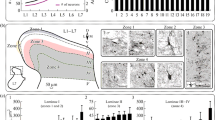Summary
Immunocytochemistry revealed that in the cat dorsal lateral geniculate nucleus (dLGN) almost all parvalbumin-positive cells are GABAergic and about 56% of the calbindin D-28K calbindin-immunoreactive neurons are also GABA-positive. On the other hand, in the same nucleus, almost all GABAergic neurons contain parvalbumin, and about 89% of the GABA-immunoreactive neurons contain calbindin. Double-labeling with calbindin and parvalbumin revealed that approximately 50% of the immunoreactive neurons are doublestained. In the PGN, virtually all neurons are GABA and parvalbuminpositive. Only a few scattered cells were also calbindin-immunoreactive. These results show that GABAergic geniculate cells can be differentiated on the basis of their calcium-binding protein immunoreactivity. Four types of immunoreactive cells are described here: (1) cells positive for GABA, parvalbumin and calbindin, (2) cells positive for GABA and parvalbumin, but negative for calbindin, (3) cells negative for GABA and parvalbumin, but positive for calbindin, (4) cells negative for GABA, parvalbumin and calbindin.
Similar content being viewed by others
References
Demeulemeester H, Vandesande F, Orban GA, Heizmann CW, Pochet R (1989) Calbindin D-28K and parvalbumin-immunoreactivity is confined to two separate neuronal subpopulations in the cat visual cortex, whereas partial coexistence is shown in the dorsal lateral geniculate nucleus. Neurosci Lett 99:6–11
Fitzpatrick D, Penny GR, Schmechel DE (1984) Glutamic acid decarboxylase-immunoreactive neurons and terminals in the lateral geniculate nucleus of the cat. J Neurosci 4:1809–1829
Friedlander MJ, Lin C-S, Stanford LR, Sherman SM (1981) Morphology of functionally identified neurons in lateral geniculate nucleus of the cat. J Neurophysiol 46:80–129
Guillery RW (1966) A study of Golgi preparations from the dorsal lateral geniculate nucleus of the adult cat. J Comp Neurol 128:21–50
Hickey TL, Guillery RW (1974) An autoradiographic study of retinogeniculate pathways in the cat and the fox. J Comp Neurol 156:239–254
Humphrey AL, Weller RE (1988) Structural correlates of functionally distinct X-cells in the lateral geniculate nucleus of the cat. J Comp Neurol 268:448–468
Jones EG, Hendry SHC (1989) Differential calcium binding protein immunoreactivity distinghuishes classes of relay neurons in monkey thalamic nuclei. Eur J Neurosci
Kaas JH, Huerta MF, Weber JT, Harting JK (1978) Patterns of retinal terminations and laminar organization of the lateral geniculate nucleus of primates. J Comp Neurol 182:517–554
Kägi U, Berchtold MW, Heizmann CW (1987) Ca2+ -binding parvalbumin in rat testis. Characterization, localization and expression during development. J Biol Chem 262:7314–7320
Le Vay S, Ferster D (1977) Relay cell classes in the lateral geniculate-nucleus of the cat and the effects of visual deprivation. J Comp Neurol 172:563–584
Lindström S (1982) Synaptic organization of inhibitory pathways to principal cells in the lateral geniculate nucleus of the cat. Brain Res 234:447–453
Mastronarde DM (1987a) Two classes of single-input X-cells in cat lateral geniculate nucleus. I. Receptive-field properties and classification of cells. J Neurophysiol 57:357–380
Mastronarde DM (1987b) Two classes of single-input X-cells in cat lateral geniculate nucleus. II. Retinal inputs and the generation of receptive field properties. J Neurophysiol 57:381–413
Mason DY, Abdulaziz Z, Falini B, Stein H (1983) Double immunoenzymatic labelling. In: Polak JM, Van Noorden S (ed) Techniques in immunocytochemistry. Wright PSG, Bristol London Boston, pp 113–128
Montero VM, Singer W (1984) Ultrastructure and synaptic relationships of neural elements containing glutamic acid decarboxylase (GAD) in the perigeniculate nucleus of the cat: a light and electron microscopic immunohistochemical study. Exp Brain Res 56:115–125
Montero VM, Zempel J (1985) Evidence for two types of GABA-containing interneurons in the A-laminae of the cat lateral-geniculate nucleus: a double-label HRP and GABA immunocytochemical study. Exp Brain Res 60:603–609
Nakane PK, Pierce GB (1967) Enzyme-labelled antibodies: preparation and application for the localization of antigens. J Hist Cytochem 14:929–931
Norton TT, Casagrande VA (1982) Laminar organization of receptive-field properties in lateral geniculate nucleus of bush baby (Galago crassicaudatus). J Neurophysiol 47:715–741
O'Hara PT, Lieberman AR, Hunt SP, Wu J-Y (1983) Neural elements containing glutamic acid decarboxylase (GAD) in the dorsal lateral geniculate nucleus of the rat: immunohistochemical studies by light and electron-microscopy. Neurosci 8:189–211
Orban GA (1984) Neuronal operations in the visual cortex. In: Barlow HB, Bullock TH, Florey E, Grüsser OJ, Peters A (eds) Studies of brain function, Vol 11. Springer, Berlin Heidelberg New York Tokyo
Sachs DH, Winn JH (1970) The use of glutaraldehyde as a coupling agent for ribonuclease and bovine serum albumin. Immunochemistry 7:581–585
Sherman SM, Koch C (1986) The control of retinogeniculate transmission in the mammalian lateral geniculate nucleus. Exp Brain Res 63:1–20
Spencer R, Charman M, Wilson PW, Lawson DEM (1978) The relationship between vitamin D-stimulated calcium transport and intestinal calcium-binding protein in the chicken. Biochem J 170:92–101
Sternberger LA, Hardy PH, Cuculis JJ, Meyer HG (1970) The unlabelled antibody-enzyme method of immunohistochemistry: preparation and properties of soluble antigen-antibody complex (horseradish peroxidase anti-horseradish peroxidase) and its use in identification of spirochetes. J Hist Cytochem 18:315–317
Stichel CC, Singer W, Heizmann CW (1988) Light and electron microscopic immunocytochemical localization of parvalbumin in the dorsal lateral geniculate nucleus of the cat: evidence for coexistence with GABA. J Comp Neurol 268:29–37
Vandesande F (1983) Immunohistochemical double staining techniques. In: Cuello AC (ed) Immunohistochemistry. Wiley, New York, pp 257–272
Vandesande F, Dierickx K, De Meye J (1977) The origin of the vasopressinergic and oxytocinergic fibres of the median eminence of the rat hypophysis. Cell Tissue Res 180:443–452
Author information
Authors and Affiliations
Rights and permissions
About this article
Cite this article
Demeulemeester, H., Arckens, L., Vandesande, F. et al. Calcium binding proteins as molecular markers for cat geniculate neurons. Exp Brain Res 83, 513–520 (1991). https://doi.org/10.1007/BF00229828
Received:
Accepted:
Issue Date:
DOI: https://doi.org/10.1007/BF00229828



